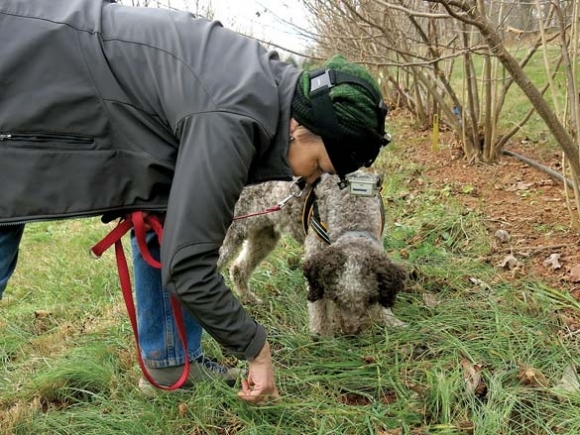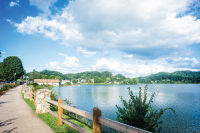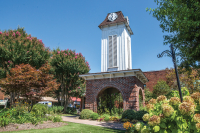Resurrecting the truffle: Researchers look to learn about cultivation potential in N.C.

An Old World delicacy tied to myths of the supernatural, the truffle is often construed as a rare exotic, likely to grace only the most expensive of culinary creations.
But truffle cultivation is seeing a surge in North Carolina, with more than 200 truffle growers popping up across the state since word began spreading in the 1990s.
One of those truffle farms is located right in the heart of Waynesville, a research project at the N.C. Cooperative Extension Mountain Research Station aiming to dispel myths and build a structure of facts around the growing of truffles in this part of the world.
“Our research was borne out of the fact that people were just kind of going for it, and all of the resources were coming from Europe and all of the research was coming out of Europe, which is obviously different from here,” said Leonora Stephanile, a horticultural research assistant on the project.
Frank and Betty Garland, owners of the pioneering Garland Truffles business in Hillsborough, donated the first set of trees planted at the test farm in 2010, inoculating them with the truffle fungus beforehand.
Seven years later, Stephanile and the others working on the project have put in many hours of thought and action toward the goal of learning as much as possible about the cultivation of a crop that is still shrouded in mystery.
Related Items
While truffles were once a booming business in Europe — the native home of the black perigord species now being grown in Waynesville — production came to a screeching halt after the world wars of the early 1900s destroyed many of the rural lands where they had grown. That gap in production caused a parallel gap in knowledge, and it’s been just in the last few decades that the world has started to relearn the art of truffle cultivation.
Until even more recently, most of that knowledge has come out of France and Spain, where the truffle has traditionally been grown. While there’s much to be learned from truffle experts in that part of the world, a crop’s cultivation is always particular to the specific climate where it’s being raised. As more people became interested in growing truffles in the U.S., the need arose for research specific to the area, and experts more readily accessible than those living their lives an ocean away.
Enter N.C. Cooperative Extension.
After the Garlands donated the trees, the organization landed a grant from the N.C. Department of Agriculture and Consumer Services called the Specialty Crop Block Grant Program, which allowed researchers to conduct various studies in the newly established truffle orchard.
On a cloudy December day in Waynesville, the patch of hazelnut trees on the test farm was quiet — but for the occasional caw of a crow — with recent rain darkening the exposed clay surrounding the trees’ entrance to the ground.
That exposed soil is a good sign, Stephanile said. The truffle fungus has an allelopathic effect on the soil, meaning that it keeps other vegetation from growing nearby. That allows the truffle fungus to thrive free from competition.

The truffle itself grows as the result of a mutually beneficial relationship between the tree and the fungus. The fungus latches onto the tree’s roots and takes energy from them to sustain itself. In return, it mines nutrients from the soil for the tree to use. Eventually, truffles form — little pebble-like growths that Stephanile describes as akin to textured dinosaur skin. Most of the time they form invisible, underground, meaning that specially trained truffle dogs are required to sniff them out.
A truffle grower can expect to start seeing truffles around year seven, and the test farm seems to be right on track, with the first truffles in the 7-year-old orchard discovered this fall, five of them so far. Stephanile hopes to find more in the coming months, with January thought to be the peak season for truffle production.
It hasn’t been a passive process. After planting the trees, the team covered the ground below them with black landscaping plastic to keep weeds away, taking that plastic off once the trees reached three years old. Meanwhile, they began liming the orchard to achieve the high pH that truffles need to thrive. Because the host trees, hazelnuts, don’t necessarily love the alkaline soil, liming was a balancing act, with the team gradually increasing the pH year by year so the trees could adapt over time.
“This year we finally got our soils back up to about the target range, and we got truffles,” Stephanile said. “We’re thinking that’s probably why we did, but we’re also taking a look at the weather.”
The team took other measures, as well. About this time last year, they found early evidence of a blight that has wiped out other truffle orchards completely. Truffle growers have been hesitant to treat the blight with fungicide, out of fear that the chemical would destroy the truffles as well.
“We’re trying to dispel that myth,” Stephanile said.
The blight on the test farm trees is now being controlled with fungicide, and the first truffles were harvested after that treatment began — so far, so good.
Some research has indicated that truffles grow better with a bit more sunlight, so to test that theory the team tried cutting down every other tree in the orchard. As it turns out, those cut-down trees are where the five truffles harvested so far were found.
“We’re wondering if maybe that shock to the tree’s system had something to do with why we’re getting truffles, but we don’t know enough to say it was this or it was that,” Stephanile said. “We’ve only harvested five truffles. From a statistical point of view, that’s not enough to say why they were where they were.”
The hope is that there will be some more firm answers to those questions in the years ahead. Assuming that the trees survive, the team hopes to continue the research. For all its allure and potential for profit — black perigord truffles can fetch $500 a pound, easy — the truffle is still something of a mystery crop. There are myriad questions as to how much water, how much sunlight or what species or cultivar of tree will produce the best crop. Future experiments, Stephanile said, could include testing its growth on oak trees, trying a polyculture orchard with oaks and hazelnuts and experimenting with spacing.
“There are definitely lots of things that we would like to do moving forward,” she said.

What is a truffle?
A truffle is a type of mushroom that grows as the result of a symbiotic relationship between tree roots and fungus. With a pungent, aromatic odor, the truffle is a coveted seasoning in a variety of dishes.
While a select few species are typically grown commercially, about 190 species of truffle have been identified in the Northern Hemisphere. The truffles typically form underground and must be harvested with the help of dogs trained to sniff them out.
Learn more at trufflegrowers.com.
The Asheville Truffle Experience
The truffle is growing in notoriety in the Asheville area, with the Asheville Truffle Experience Feb. 23-25 coming to offer the interested an opportunity to experience every facet of truffle culture. The event will offer tastings, wine-paired dinners, speakers, demonstrations and hands-on culinary lessons.
A truffle dog demonstration at the Mountain Research Station in Waynesville will also be part of the event. Registration is offered online at www.ashevilletruffle.com/index.html, with package and a la carte prices both available.









